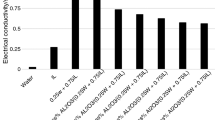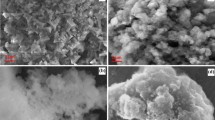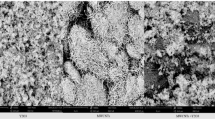Abstract
Ionanofluids (INF) are combinations of ionic liquid (IL) and nanoparticles (NP) with superior thermophysical properties. In the present study, measurement of thermophysical profile of IL, 1-ethyl-3-methylimidazolium chloride ([EMiM]Cl) in which Al2O3 NPs are dispersed were undertaken in the temperature range of 303.15–333.15 K. INFs were prepared by dispersing Al2O3 NPs in different mass concentrations of 0.5, 1.0, 2.5, 5.0, and 10%. The results showed that specific heat and thermal conductivity increase with both concentration and temperature. In contrast, the viscosity and density increase with concentration and decrease with temperature rise. The maximum INF thermal conductivity and viscosity enhancements were 21.9% and 77.6% for a mass concentration of 10% compared to IL at 333.15 K and 303.15 K. Electrical conductivity decreases with NP addition and increases linearly with an increment in temperature. Based on the measured results, a correlation for the specific heat, thermal conductivity, and viscosity of INF was proposed. Further, the heat transfer performance of studied INF is theoretically estimated based on the experimental thermophysical properties. Finally, for high-temperature applications methylimidazolium chloride-based INFs can be used as an efficient candidate as primary heat transfer fluid.














Similar content being viewed by others
Abbreviations
- [BMIM][BF4]:
-
1-Butyl-3-methylimidazolium tetrafluoroborate
- C p :
-
Specific heat (J kg−1 K−1)
- [C2mim][CH3SO3]:
-
1-Ethyl-3-methylimidazolium methanesulfonate
- [C4mim][NTf2]:
-
1-Butyl-3-methylimidazolium bis(trifluoromethylsulfonyl) imide
- [C4mpyrr][NTf2]:
-
N-Butyl-N-methylpyrrolidinium bis(trifluoromethanesulfonyl) imide
- [C4mmim][NTf2]:
-
1-Butyl-2,3-dimethylimidazolium bis(trifluoromethylsulfonyl)imide
- EC:
-
Electrical conductivity
- FESEM:
-
Field emission scanning electron microscope
- [HMIM] [BF4]:
-
1-Hexyl-3-methylimidazolium tetrafluoroborate
- IL:
-
Ionic liquid
- INF:
-
Ionanofluid
- ILF:
-
Internal laminar flow
- ITF:
-
Internal turbulent flow
- k :
-
Thermal conductivity (W m−1 K−1)
- [N4111][NTf2]:
-
Butyl trimethylammonium bis(trifluoromethylsulfonyl) imide
- m :
-
Mass fraction
- Q :
-
Heat input
- T :
-
Temperature
- v :
-
Volume
- Δ :
-
Uncertainty
- ρ :
-
Density (kg m−3)
- φ :
-
Mass fraction
- μ :
-
Viscosity (mPa s)
- bf:
-
Base fluid
- nf:
-
Nanofluid
- p:
-
Particle
- vol:
-
Volume (%)
References
Gupta M, Singh V, Kumar R, Said Z. A review on thermophysical properties of nanofluids and heat transfer applications. Renew Sustain Energy Rev. 2017;74:638–70. https://doi.org/10.1016/j.rser.2017.02.073.
Parashar N, Yahya SM. Thermophysical and rheological properties of hybrid nanofluids: a review on recent studies. J Therm Anal Calorim. 2021;1:1–16. https://doi.org/10.1007/s10973-021-10854-8.
Kanti P, Sharma KV, Ramachandra CG, Gupta M. Thermal performance of fly ash nanofluids at various inlet fluid temperatures: an experimental study. Int Commun Heat Mass Transf. 2020;119:104926.
Wang XQ, Mujumdar AS. A review on nanofluids—part II: experiments and applications. Braz J Chem Eng. 2008;25:631–48. https://doi.org/10.1590/s0104-66322008000400002.
Mintsa HA, Roy G, Nguyen CT, Doucet D. New temperature-dependent thermal conductivity data for water-based nanofluids. Int J Therm Sci. 2009;48:363–71. https://doi.org/10.1016/j.ijthermalsci.2008.03.009.
Sundar LS, Sharma KV, Singh MK, Sousa ACM. Hybrid nanofluids preparation, thermal properties, heat transfer and friction factor—a review. Renew Sustain Energy Rev. 2017;68:185–98. https://doi.org/10.1016/j.rser.2016.09.108.
Gupta M, Singh VK, Kumar S, Dilbaghi N, Said Z. Up to date review on the synthesis and thermophysical properties of hybrid nanofluids. J Clean Prod. 2018;190:169–92. https://doi.org/10.1016/j.rser.2017.02.073.
Azmi WH, Sharma KV, Sarma PK, Mamat R, Anuar S, Rao DV. Experimental determination of turbulent forced convection heat transfer and friction factor with SiO2 nanofluid. Exp Therm Fluid Sci. 2013;51:103–11. https://doi.org/10.1016/j.expthermflusci.2013.
Shahsavar A, Salimpour MR, Saghafian M, Shafii MB. Effect of temperature and concentration on thermal conductivity and viscosity of ferrofluid loaded with carbon nanotubes. Heat Mass Transf. 2016;52:2293–301. https://doi.org/10.1007/s00231-015-1743-8.
Tawfik MM. Experimental studies of nanofluid thermal conductivity enhancement and applications: a review. Renew Sustain Energy Rev. 2017;75:1239–53. https://doi.org/10.1016/j.rser.2016.11.111.
Wadekar VV. Ionic liquids as heat transfer fluids—an assessment using industrial exchanger geometries. Appl Therm Eng. 2017;111:1581–7. https://doi.org/10.1016/j.applthermaleng.2016.04.156.
Chernikova EA, Glukhov LM, Krasovskiy VG, Kustov LM, Vorobyeva MG, Koroteev AA. Ionic liquids as heat transfer fluids: comparison with known systems, possible applications, advantages and disadvantages. Russ Chem Rev. 2015;84:875–90. https://doi.org/10.1070/rcr4510.
Nieto de Castro CA, Lourenço MJV, Ribeiro APC, Langa E, Vieira SC, Goodrich P, Hardacre C. Thermal properties of ionic liquids and ionanofluids of imidazolium and pyrrolidinium liquids. J Chem Eng Data. 2010;55(2):653–61. https://doi.org/10.1021/je900648p.
Zhang FF, Zheng FF, Wu XH, Yin YL, Chen G. Variations of thermophysical properties and heat transfer performance of nanoparticle-enhanced ionic liquids. R Soc Open Sci. 2019;6:182040. https://doi.org/10.1098/rsos.182040.
Paul TC, Morshed AK, Fox EB, Khan JA. Enhanced thermophysical properties of NEILs as heat transfer fluids for solar thermal applications. Appl Therm Eng. 2017;110:1–9. https://doi.org/10.1016/j.applthermaleng.2016.08.004.
Jorjani S, Mozaffarian M, Pazuki G. A novel nanodiamond based ionanofluid: experimental and mathematical study of thermal properties. J Mol Liq. 2018;271:211–9. https://doi.org/10.1016/j.molliq.2018.08.116.
Cherecheş EI, Bejan D, Ibanescu C, Danu M, Minea AA. Ionanofluids with [C2mim][CH3SO3] ionic liquid and alumina nanoparticles: an experimental study on viscosity, specific heat, and electrical conductivity. Chem Eng Sci. 2021;229:116140. https://doi.org/10.1016/j.ces.2020.116140.
Cherecheş EI, Minea AA. Experimental evaluation of electrical conductivity of nanofluids based on water–[C2mim][CH3SO3] ionic liquids mixtures and alumina nanoparticles. J Therm Anal Calorim. 2021;145:3151–7. https://doi.org/10.1007/s10973-020-09925-z.
Chen W, Zou C, Li X. An investigation into the thermophysical and optical properties of SiC/ionic liquid nanofluid for direct absorption solar collector. Sol Energy Mater Sol Cells. 2017;163:157–63. https://doi.org/10.1016/j.solmat.2017.01.029.
Zhang L, Liu J, He G, Ye Z, Fang X, Zhang Z. Radiative properties of ionic liquid-based nanofluids for medium to high-temperature direct absorption solar collectors. Sol Energy Mater Sol Cells. 2014;130:521–8. https://doi.org/10.1016/j.solmat.2014.07.040.
Józ’wiak B, Boncel S. Rheology of ionanofluids—a review. J Mol Liq. 2020;302:112568. https://doi.org/10.1016/j.molliq.2020.112568.
Shakeel A, Mahmood H, Farooq U, Ullah Z, Yasin S, Iqbal T, Chassagne C, Moniruzzaman M. Rheology of pure ionic liquids and their complex fluids: a review. ACS Sustain Chem Eng. 2019;7:13586–626. https://doi.org/10.1021/acssuschemeng.9b02232.
Oster K, Hardacre C, Jacquemin J, Ribeiro APC, Elsinawi A. Understanding the heat capacity enhancement in ionic liquid-based nanofluids (ionanofluids). J Mol Liq. 2018;253:326–39. https://doi.org/10.1016/j.molliq.2018.01.025.
Zhou SQ, Ni R. Measurement of the specific heat capacity of water-based Al2O3 nanofluid. Appl Phys Lett. 2008;92:93123. https://doi.org/10.1063/1.2890431.
Wang L, Tan Z, Meng S, Liang D, Li G. Enhancement of molar heat capacity of nanostructured Al2O3. J Nanopart Res. 2001;3:483–7.
Paul TC, Morshed AKMM, Fox EB, Khan JA. Thermal performance of Al2O3 nanoparticle enhanced ionic liquids (NEILs) for concentrated solar power (CSP) applications. Int J Heat Mass Transf. 2015;85:585–94. https://doi.org/10.1016/j.ijheatmasstransfer.
Hasse B, Lehmann J, Assenbaum D, Wasserscheid P, Leipertz A, Fröba AP. Viscosity, interfacial tension, density, and refractive index of ionic liquids [EMIM][MeSO3],[EMIM][MeOHPO2], [EMIM][OcSO4], and [BBIM][NTf2] in dependence on the temperature at atmospheric pressure. J Chem Eng Data. 2009;54(9):2576–83. https://doi.org/10.1021/je900134z.
Freire MG, Teles ARR, Rocha MAA, Schröder B, Neves CMSS, Carvalho PJ, Evtuguin DV, Santos LMNBF, Coutinho JAP. Thermophysical characterization of ionic liquids able to dissolve biomass. J Chem Eng Data. 2011;56(12):4813–22. https://doi.org/10.1021/je200790q.
Safarov J, Huseynova G, Bashirov M, Hassel E, Abdulagatov I. High temperatures and high pressures density measurements of 1-ethyl-3-methylimidazolium methanesulfonate and Tait-type equation of state. J Mol Liq. 2017;238:347–58. https://doi.org/10.1016/j.molliq.2017.05.013.
Safarov J, Huseynova G, Bashirov M, Hassel E, Abdulagatov I. Viscosity of 1-ethyl-3-methylimidazolium methanesulfonate over a wide range of temperature and Vogel–Tamman–Fulcher model. Phys Chem Liq. 2018;56(6):703–17. https://doi.org/10.1016/j.molliq.2017.05.013.
Cabaleiro D, Nimo J, Pastoriza-Gallego MJ, Piñeiro MM, Legido LL. Thermal conductivity of dry anatase and rutile nano-powders and ethylene and propylene glycol-based TiO2 nanofluids. J Chem Thermodyn. 2015;83:67–76. https://doi.org/10.1016/j.jct.2014.12.001.
Kanti P, Sharma KV, Ramachandra CG, Panitapu B. Stability and thermophysical properties of fly ash nanofluid for heat transfer applications. Heat Transf. 2020;49(8):4722–37. https://doi.org/10.1002/htj.21849.
Wang W, Wu Z, Li B, et al. A review on molten-salt-based and ionic-liquid-based nanofluids for medium-to-high temperature heat transfer. J Therm Anal Calorim. 2019;136:1037–51. https://doi.org/10.1007/s10973-018-7765-y.
Pak BC, Cho YI. Hydrodynamic and heat transfer study of dispersed fluids with submicron metallic oxide particles. Exp Heat Transf. 1998;11(2):151–70. https://doi.org/10.1080/08916159808946559.
Raud R, Hosterman B, Diana A, Steinberg TA, Will G. Experimental study of the interactivity, specific heat, and latent heat of fusion of water-based nanofluids. Appl Therm Eng. 2017;117:164–8. https://doi.org/10.1016/j.applthermaleng.2017.02.033.
Batchelor GK. The effect of Brownian motion on the bulk stress in a suspension of spherical particles. J Fluid Mech. 1977;83(1):97–117. https://doi.org/10.1017/s0022112077001062.
Wang X, Xu X, Choi SUS. Thermal conductivity of nanoparticle-fluid mixture. J Thermophys Heat Transf. 1999;13(4):474–80.
Kanti PK, Sharma KV, Minea AA, Kesti V. Experimental and computational determination of heat transfer, entropy generation, and pressure drop under turbulent flow in a tube with fly ash-Cu hybrid nanofluid. Int J Therm Sci. 2021;167:107016. https://doi.org/10.1016/j.ijthermalsci.2021.107016.
Yashawantha KM, Afzal A, Ramis MK, Ukkund SJ. Experimental investigation on physical and thermal properties of graphite nanofluids. AIP Conf Proc. 2018;2039:020057. https://doi.org/10.1063/1.5079016.
Yashawantha KM, Vinod AV. ANN modelling and experimental investigation on effective thermal conductivity of ethylene glycol: water nanofluids. J Therm Anal Calorim. 2020. https://doi.org/10.1007/s10973-020-09756-y.
Wang W, Wu Z, Zhang Y, Li B, Sundén B. Thermophysical properties and convection heat transfer behaviour of ionic liquid [C4mim][NTf2] at medium temperature in helically corrugated tubes. Appl Therm Eng. 2018;142:457–65. https://doi.org/10.1016/j.applthermaleng.2018.07.035.
Maxwell JC. A treatise on electricity and magnetism. London: Clarendon; 1973.
Babita SK, Sharma SM, Gupta SS. Preparation and evaluation of stable nanofluids for heat transfer application: a review. Exp Therm Fluid Sci. 2016;79:202–12. https://doi.org/10.1016/j.expthermflusci.2016.06.029.
Zhang H, Qin S, Zhai Y, et al. The changes induced by pH in TiO2/water nanofluids: stability, thermophysical properties and thermal performance. Powder Technol. 2019. https://doi.org/10.1016/j.powtec.2020.09.004.
Cherecheş EI, Prado JJ, Ibanescu C, et al. viscosity and isobaric specific heat capacity of alumina nanoparticle enhanced ionic liquids: an experimental approach. J Mol Liq. 2020;317:114020. https://doi.org/10.1016/j.molliq.2020.114020.
Wang XJ, Li XF. The influence of pH on nanofluids’ viscosity and thermal conductivity. Chin Phys Lett. 2009;26(5):056601. https://doi.org/10.1088/0256-307x/26/5/056601.
Hentschke R. On the specific heat capacity enhancement in nanofluids. Nanoscale Res Lett. 2016;11:88. https://doi.org/10.1186/s11671-015-1188-5.
Bridges NJ, Visser AE, Fox EB. Potential of nanoparticle-enhanced ionic liquids (NEILs) as advanced heat-transfer fluids. Energy Fuels. 2011;25:4862–4. https://doi.org/10.1021/ef2012084.
Jang SP, Choi SUS. Role of Brownian motion in the enhanced thermal conductivity of nanofluids. Appl Phys Lett. 2004;44(21):4316–8. https://doi.org/10.1063/1.1756684.
Leong KC, Yang C, Murshed SMS. A model for the thermal conductivity of nanofluids–the effect of the interfacial layer. J Nanopart Res. 2006;8:245–54. https://doi.org/10.1007/s11051-005-9018-9.
Li H, Wang L, He Y, Hu Y, Zhu J, Jiang B. Experimental investigation of thermal conductivity and viscosity of ethylene glycol-based ZnO nanofluids. Appl Therm Eng. 2015;88:363–8. https://doi.org/10.1016/j.applthermaleng.2014.10.071.
Prasher R, Song D, Wang J, Phelan P. Measurements of nanofluid viscosity and its implications for thermal applications. Appl Phys Lett. 2006;89:133108–11. https://doi.org/10.1063/1.2356113.
Lasance CJ, Simons RE. Advances in high-performance cooling for electronics. Electron Cool. 2005;11:22–39.
Mansour RB, Galanis N, Nguyen CT. Experimental study of mixed convection with watereAl2O3 nanofluid in an inclined tube with uniform wall heat flux. Appl Therm Eng. 2007;27:240–9. https://doi.org/10.1016/j.ijthermalsci.2010.03.016.
Fendt S, Padmanabhan S, Blanch HW, Prausnitz JM. Viscosities of acetate or chloride-based ionic liquids and some of their mixtures with water or other common solvents. J Chem Eng Data. 2011;56:1–34. https://doi.org/10.1021/je1007235.
Author information
Authors and Affiliations
Corresponding author
Additional information
Publisher's Note
Springer Nature remains neutral with regard to jurisdictional claims in published maps and institutional affiliations.
Rights and permissions
Springer Nature or its licensor holds exclusive rights to this article under a publishing agreement with the author(s) or other rightsholder(s); author self-archiving of the accepted manuscript version of this article is solely governed by the terms of such publishing agreement and applicable law.
About this article
Cite this article
Kanti, P.K., Chereches, E.I., Minea, A.A. et al. Experiments on thermal properties of ionic liquid enhanced with alumina nanoparticles for solar applications. J Therm Anal Calorim 147, 13027–13038 (2022). https://doi.org/10.1007/s10973-022-11534-x
Received:
Accepted:
Published:
Issue Date:
DOI: https://doi.org/10.1007/s10973-022-11534-x




